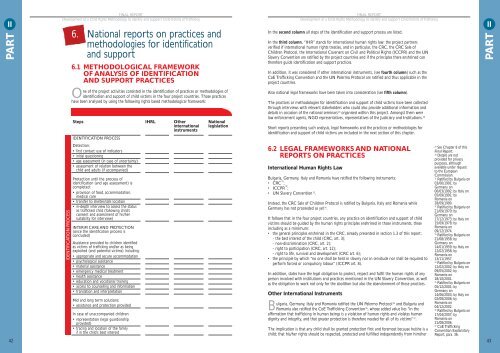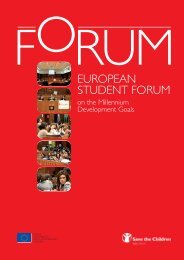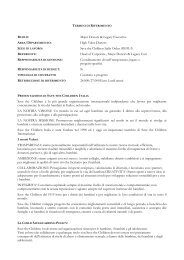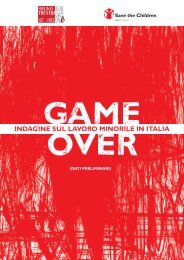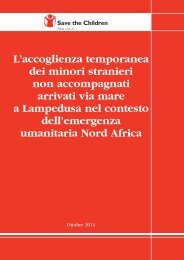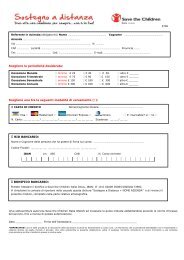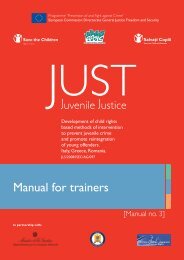FINAL REPORT - Save the Children Italia Onlus
FINAL REPORT - Save the Children Italia Onlus
FINAL REPORT - Save the Children Italia Onlus
Create successful ePaper yourself
Turn your PDF publications into a flip-book with our unique Google optimized e-Paper software.
IIPART<strong>FINAL</strong> <strong>REPORT</strong>Development of a Child Rights Methodology to Identify and Support Child Victims of Trafficking6. National reports on practices andmethodologies for identificationand support6.1 METHODOLOGICAL FRAMEWORKOF ANALYSIS OF IDENTIFICATIONAND SUPPORT PRACTICESOne of <strong>the</strong> project activities consisted in <strong>the</strong> identification of practices or methodologies ofidentification and support of child victims in <strong>the</strong> four project countries. Those practiceshave been analysed by using <strong>the</strong> following rights based methodological framework:StepsIDENTIFICATION PROCESSIHRLO<strong>the</strong>rinternationalinstrumentsNationallegislation<strong>FINAL</strong> <strong>REPORT</strong>Development of a Child Rights Methodology to Identify and Support Child Victims of TraffickingIn <strong>the</strong> second column all steps of <strong>the</strong> identification and support process are listed.In <strong>the</strong> third column, “IHR” stands for international human rights law: <strong>the</strong> project partnersverified if international human rights treaties, and in particular, <strong>the</strong> CRC, <strong>the</strong> CRC Sale of<strong>Children</strong> Protocol, <strong>the</strong> International Covenant on Civil and Political Rights (ICCPR) and <strong>the</strong> UNSlavery Convention are ratified by <strong>the</strong> project countries and if <strong>the</strong> principles <strong>the</strong>re enshrined can<strong>the</strong>refore guide identification and support practices.In addition, it was considered if o<strong>the</strong>r international instruments, (see fourth column) such as <strong>the</strong>CoE Trafficking Convention and <strong>the</strong> UN Palermo Protocol are ratified and thus applicable in <strong>the</strong>project countries.Also national legal frameworks have been taken into consideration (see fifth column).The practices or methodologies for identification and support of child victims have been collectedthrough interviews with relevant stakeholders who could also provide additional information anddetails in occasion of <strong>the</strong> national seminars 29 organised within this project. Amongst <strong>the</strong>m werelaw enforcement agents, NGO representatives, representatives of <strong>the</strong> Judiciary and Institutions. 30Short reports presenting such analysis, legal frameworks and <strong>the</strong> practices or methodologies foridentification and support of child victims are included in <strong>the</strong> next section of this chapter.IIPART42IDENTIFICATION PROCESSDetection:• first contact: use of indicators• initial questioning• age assessment (in case of uncertainty)• assessment of relation between <strong>the</strong>child and adults (if accompanied)Protection until <strong>the</strong> process ofidentification (and age assessment) iscompleted:• provision of food, accommodation,medical care• transfer to shelter/safe location• in-depth interview to assess <strong>the</strong> statusas trafficked child (following child’sconsent and assessment of his/hersuitability for interview)INTERIM CARE AND PROTECTION(once <strong>the</strong> identification process isconcluded)Assistance provided to children identifiedas victims of trafficking and/or as beingexploited (and potential victims). Including:• appropriate and secure accommodation• psychological assistance• material assistance• emergency medical treatment• health assistance• education and vocational training• access to counselling and information• translation and interpretationMid and long term solutions:• assistance and protection providedIn case of unaccompanied children:• representation (legal guardianshipprovided)• tracing and location of <strong>the</strong> familyif in <strong>the</strong> child’s best interest6.2 LEGAL FRAMEWORKS AND NATIONAL<strong>REPORT</strong>S ON PRACTICESInternational Human Rights LawBulgaria, Germany, Italy and Romania have ratified <strong>the</strong> following instruments:• CRC 31 ;• ICCPR 32 ;• UN Slavery Convention 33 .Instead, <strong>the</strong> CRC Sale of <strong>Children</strong> Protocol is ratified by Bulgaria, Italy and Romania whileGermany has not proceeded as yet 34 .It follows that in <strong>the</strong> four project countries, any practice on identification and support of childvictims should be guided by <strong>the</strong> human rights principles enshrined in those instruments, <strong>the</strong>seincluding as a minimum:• <strong>the</strong> general principles enshrined in <strong>the</strong> CRC, already presented in section 1.3 of this report:- <strong>the</strong> best interest of <strong>the</strong> child (CRC, art. 3);- non-discrimination (CRC, art. 2);- right to participation (CRC, art. 12);- right to life, survival and development (CRC art. 6);• <strong>the</strong> principle by which “no one shall be held in slavery nor in servitude nor shall be required toperform forced or compulsory labour” (ICCPR art. 8).In addition, states have <strong>the</strong> legal obligation to protect, respect and fulfil <strong>the</strong> human rights of anyperson involved with institutions and practices mentioned in <strong>the</strong> UN Slavery Convention, as wellas <strong>the</strong> obligation to work not only for <strong>the</strong> abolition but also <strong>the</strong> abandonment of those practices.O<strong>the</strong>r International InstrumentsBulgaria, Germany, Italy and Romania ratified <strong>the</strong> UN Palermo Protocol 35 and Bulgaria andRomania also ratified <strong>the</strong> CoE Trafficking Convention 36 , whose added value lies “in <strong>the</strong>affirmation that trafficking in human beings is a violation of human rights and violates humandignity and integrity, and that greater protection is <strong>the</strong>refore needed for all of its victims” 37 .The implication is that any child shall be granted protection first and foremost because he/she is achild; that his/her rights should be respected, protected and fulfilled independently from him/her29See Chapter 8 of thisFinal Report.30Details are notprovided for privacypurposes, althoughavailable under requestto <strong>the</strong> EuropeanCommission.31Ratified by Bulgaria on03/06/1991; byGermany on06/03/1992; by Italy on05/09/1991; byRomania on28/09/1990.32Ratified by Bulgaria on21/09/1970; byGermany on17/12/1973; by Italy on15/09/1978; byRomania on09/12/1974.33Ratified by Bulgaria on21/08/1958; byGermany on14/01/1959; by Italy on12/02/1958; byRomania on13/11/1957.34Ratified by Bulgaria on12/02/2002; by Italy on09/05/2002; byRomania on18/10/2001.35Ratified by Bulgaria on05/12/2001; byGermany on14/06/2003; by Italy on02/08/2006; byRomania on04/12/2002.36Ratified by Bulgaria on17/04/2007; byRomania on21/08/2006.37CoE TraffickingConvention ExplanatoryReport, para. 36.43


